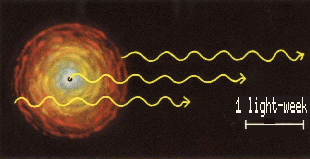-
The large distances and extreme brightness of the quasars implies tremendous
energy output; how do they do that? The question was complicated by the
discovery that quasars
vary in brightness, sometimes by huge amounts in
periods as small as a week or so. There is a simple argument that the size of
a variable, luminous object cannot be larger than the distance that light
travels during its time of variation (i.e. if an object varies
significantly in brightness over a period of a week, it cannot be larger than
a light-week in size.

The Variability Timescale of a Quasar
Limits the Size of its Light Emitting Region
Suppose the "quasar" above flashed in brightness like a photographic flash. Light would begin travelling from all three points at the same time, but light from the center of the quasar would always be a light week behind light emitted from the front. Light from the center would reach an observer a week after detection of light from the front, and light from the back of the quasar would be detected another week later. This "flash" would be observed as a rise and fall in the brightness over a two week period.
The variability of 3C273, 3C279 and other quasars requires that the quasar produce its luminosity greater than a thousand galaxies of billions of stars from a region smaller than our solar system!
Material falling into a black hole near the nucleus of a galaxy may release up to about 10% of its rest energy in the form of gravitational potential energy transformed into x-rays, relativistically moving particles, etc. which produce the phenomena that we see. Some astronomers speculate that stars which orbit to near the central quasar may be first puffed up by the intense radiation field, then tidally disrupted by the intense gravitational field, and finally pulled into a swirling disk of accreted material which will eventually be swallowed by the massive central black hole.
The release of gravitational energy by a massive black hole (about 100 million solar masses) "eating" one star per year would power a typical quasar.